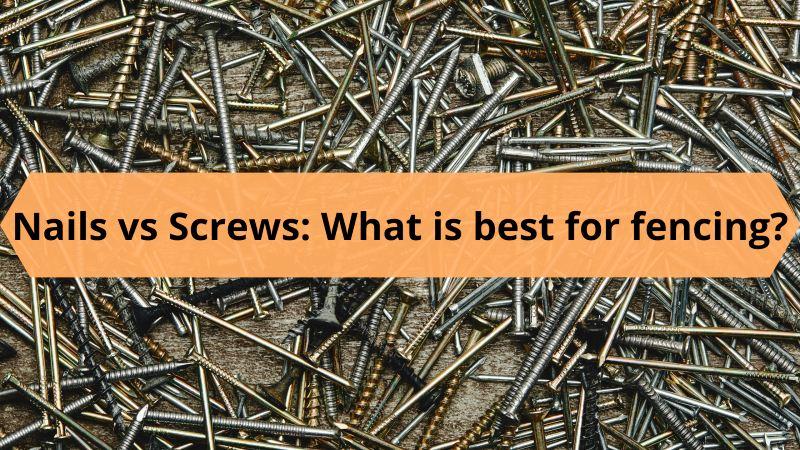Nails vs Screws: Which One is Best for Fencing?
Nails and Screws are used widely as fasteners. Considering the material of the surface and cost, there are many differences between them. In this article, you will get to know about the basics of nails and screws, their pros and cons, and what is the best fastener for wood fencing between them.

The Basics of Nails and Screws
Nails: Nails are a type of metal fastener that has a flat head, sharp tip, and smooth shank. However, Some nails can be headless. Usually, a hammer or any pounding force is used to drive the nails into the surface. Nails are cheaper than any other fasteners and can be installed quickly. The most common nails are made of steel.
Screws: Screws are another type of metal fasteners with a slotted head, sharp tip, and threaded sink. Usually, a screwdriver is used to twist the screws into the surface. The threaded body penetrates the surface of the material. However, a pre-drilled hole is required sometimes. Some screws are longer than the usual ones. The thread can be shown only from the middle to the bottom part of the screws. It is generally more expensive than nails.
Pros and Cons of Nails and Screws
According to the basics of nails and screws, it has been noticed that they are different by their design and area of work. Let’s have a look at their pros and cons. Indeed, it will be easy to decide which one you should choose according to your task.
Pros and Cons of Nails
Let’s see the advantages of nails
- Easy bend: As there is no threading on the shank, it’s easy to bend or drive the nail into the surface.
- Hard to remove: You will need a lot of effort to remove a nail from the surface. You can’t twist it like a screw. So, the surface will stick together, and there is less possibility of coming off.
- Fast driven: It takes less time to drive a nail with a pounding force or a hammer. If you are using a nail gun, it will take more than a second to drive it into the surface.
- Make your own way: As we know that most of the nails have a flat head. But if you need a headless nail, you can make it on your own. Even you can flatten the tip according to your work as well.
Now let’s have a look at the disadvantages of nails.
- Hard to remove: Removing a nail can be a worst-case if you place it on the wrong surface. Remember, once you drive a nail on a surface, there is no way to turn back. It is hard to remove, especially when you don’t want to do damage in the wood.
- Possibility of damaging the surface: Generally, nails are driven by a hammer. If you are not conscious and careful with the force you are given while driving; serious damages can happen with the surface. Be careful and measure your force while driving it, especially when you are working on wood.
- Can not hold things: Honestly, Nails are excellent fasteners. But sometimes you want to stick out some of your fasteners’ parts to make it as a hook so that you can hang something. As there is no thread on the shank, nails can not hold things up for a long time.
Pros and Cons of Screws
Now it’s time to brush your eyes on some advantages of screws:
- Hold it firm: Screws can hold two different pieces of wood stronger. The threads on its shank help it to make a stronghold between the surfaces. It will be stronger if you use wood glue.
- Safe power tool: Nail guns can be dangerous to use if you don’t have any experience of using them. But, a screwdriver is much safer than that. And that is the reason why people have more screwdrivers than a nail gun.
- Easy remove: You can easily remove the surface from the screw by twisting it with a driver. Furthermore, there is a possibility of less damage than nails.
The disadvantages of screws are given below:
- Break easily: Screw can break easily while twisting it.
- Take time to drive: As screws are driven by twisting with a screwdriver, it takes a longer time to drive on a surface.
- Expensive: screws are relatively more costly than nails.
- Internal damage of the surface: Choose the size and the length of your screw wisely. Wrong size and length can lead you to damage.
Nails or Screws for Fence: What Should be Your Choice?
Both Nails and Screws are worked effectively on wooden fencing. But, still, there is a question like which one is the best for fencing.
The answer depends on the material you are using and where you are using it. Nails are easily driven fasteners, can hold surfaces for a limited period, and are hard to remove.
So if you are making a fence for your garden or dog house, it will be the right decision to use nails rather than screws.
Read More: List of Best Fencing Nailer With Review
But, if you want fences for the outside of your house, you need to use screws as they can hold the surface strong and can be removed easily whenever you want to.
Conclusion
You will find many kinds of fasteners but always choose the fasteners according to the materials you are using. It will help you to get the desired result you want.
